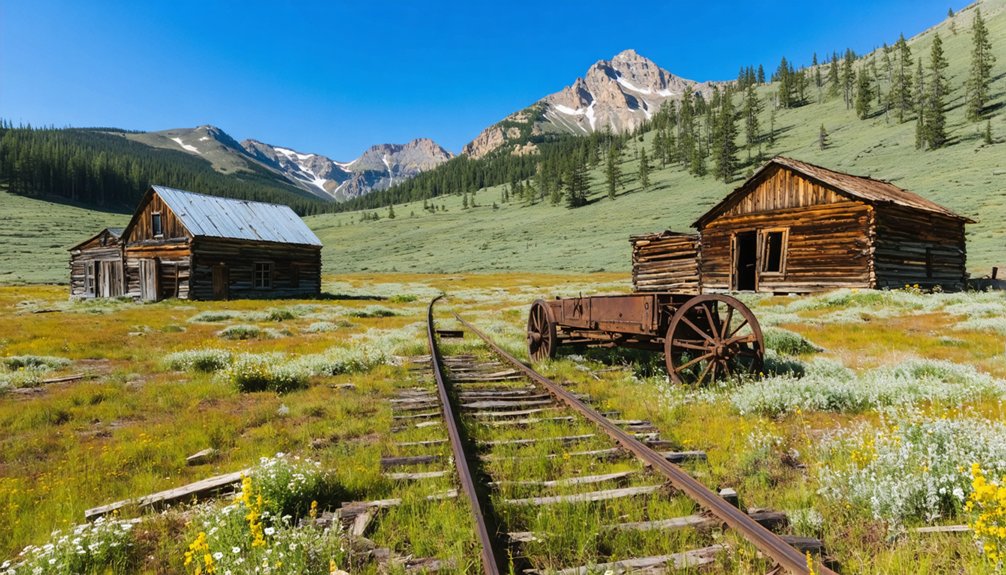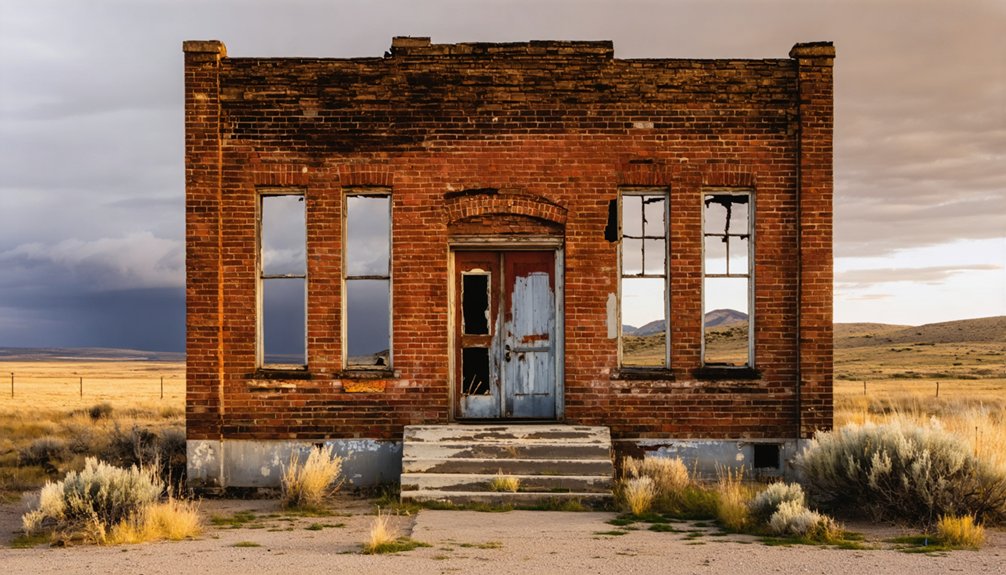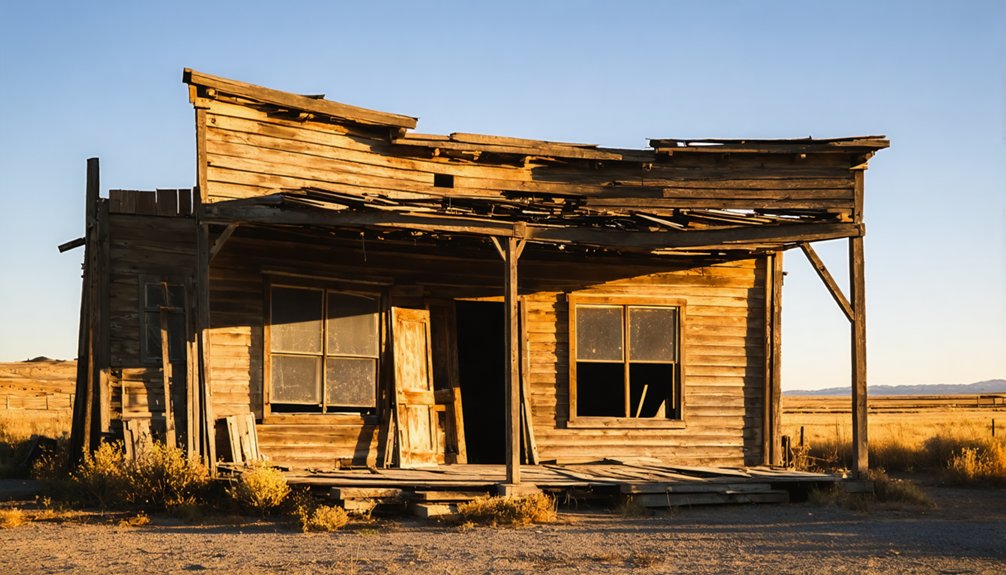You’ll find Placer Basin tucked away in Idaho’s rugged Boise mountains, where an 1862 gold discovery by George Grimes and Moses Splawn sparked a remarkable transformation. This remote valley exploded into a thriving town of 5,000, complete with saloons, churches, and a Wells Fargo stage line. Though the gold eventually ran dry and fires took their toll, today’s ghost town still holds fascinating remnants of its glory days – and there’s so much more to its pioneering story.
Key Takeaways
- Placer Basin transformed from six cabins in 1862 to a bustling gold mining town of 5,000 residents by summer 1863.
- The area produced over $53 million in gold and silver between 1862-1914, making it one of Idaho’s most significant mining regions.
- By 1870, the population dropped below 400 as placer deposits depleted, with an 1899 fire accelerating the town’s decline.
- Original structures including mill ruins and cabin foundations remain, though many are on private property requiring permission to visit.
- Today, a small community maintains historic buildings while offering seasonal guided tours of preserved mining sites.
The Birth of a Mining Frontier
When George Grimes and Moses Splawn’s party struck gold on Grimes Creek in August 1862, they couldn’t have known they’d spark one of Idaho’s most explosive mining booms.
A chance gold discovery by two prospectors in 1862 Idaho set off an epic rush that would forever change the territory.
You would’ve seen prospectors flooding the basin by the hundreds despite Native American resistance, all hoping to strike it rich using basic placer mining techniques.
Within months, you’d have found yourself among thousands of fortune seekers, with some pulling in an incredible $100-$200 daily.
The mining techniques were straightforward – washing loose gold from gravel and clay in local waterways. Like the stamp mills used later in Pierce, miners continually evolved their methods to improve extraction.
If you’d arrived in Placerville by mid-January 1863, you’d have joined roughly 1,000 residents, while across the basin, 4,000 miners worked claims through prospecting challenges like scarce water and harsh conditions.
The promise of freedom and fortune transformed this wilderness into a bustling frontier overnight. The region’s wealth was so immense that from 1862 to 1914, miners extracted over $53 million in gold and silver from Boise County.
Peak Years and Golden Dreams
As miners poured into Placerville during 1864, you’d have witnessed the town transform into a bustling hub of 2,500 souls chasing golden dreams.
During the peak of the gold rush, miners earned up to $60 daily using basic placer mining techniques, while the town’s infrastructure grew to match their prosperity.
- You’d find 13 saloons and 7 restaurants serving hungry prospectors after a day’s work.
- Local miners adapted to seasonal water flows, maximizing their yields during spring thaws.
- The town’s formal street grid and plaza reflected its evolution from camp to civilization.
The Boise Basin’s riches drew diverse settlers, including families who established churches, schools, and specialty shops.
The Empire Hotel and International became prominent landmarks as the town developed its business district.
Unlike other mining camps, Placerville’s strong community foundation helped it weather the inevitable decline as easy-to-reach placer gold diminished.
Though mining slowed significantly, the arrival of gold dredge industry in 1910 brought a brief resurgence to the area.
Life in Early Placerville
Though Placerville began modestly with just six cabins in December 1862, you’d hardly recognize the settlement by early summer 1863 as it exploded into a proper town of 300 buildings and 5,000 residents.
Unlike typical rough-and-tumble mining camps, Placerville’s social dynamics reflected a more stable community, with families setting down roots and women establishing businesses like millinery shops and dressmaking services.
Unlike many wild frontier towns, Placerville fostered a civilized community where families thrived and women entrepreneurs built lasting businesses.
You’d find yourself well-supplied in this bustling hub, with thirteen saloons to wet your whistle, seven restaurants to fill your belly, and various shops to meet your needs.
The town’s community resilience showed in its organized layout, complete with a central plaza, and its commitment to civilization through churches, schools, and lodges. Located in Boise County, the town became a significant mining settlement in Idaho Territory.
Even stage service connected you to Walla Walla every other day.
The Vanishing Boom Town
You’ll find it hard to believe that Placerville, which bustled with ninety houses and numerous businesses in 1863, would see its population plummet below 400 by 1870.
The town’s decline accelerated as rich placer deposits ran dry and devastating fires, particularly the 1899 blaze, destroyed much of its infrastructure.
Located in the scenic Boise Basin region, the area’s rugged terrain and dense pine forests created challenging conditions for early settlers. Today, you can walk through what remains of this once-thriving mining hub, where silent buildings and weathered remnants tell the story of a classic boom-and-bust cycle that shaped many Western frontier towns. The nearby region became one of the largest gold rushes since the California gold rush, drawing thousands of prospectors and settlers to the area.
Rise and Swift Fall
When gold placers were discovered in the Boise Basin region in late 1862, Placerville sprang to life with remarkable speed.
You’d have found yourself amid a bustling frontier town where economic shifts transformed the landscape overnight. Within months, nearly 90 houses dotted the settlement, alongside thirteen saloons and countless shops. The discovery by Moses Splan and Grimes marked the beginning of the largest gold rush since 1849. Much like double-entry bookkeeping revolutionized banking in Florence, this discovery transformed the region’s economy.
- Daily earnings for miners reached $8-$20, with lucky prospectors striking it rich at $100-$200
- The Pioneer Mill became the region’s first ten-stamp mill, revolutionizing mining techniques
- By 1863, nearby Idaho City exploded to 6,000 residents, becoming the Pacific Northwest’s largest city
But you can’t outrun Mother Nature’s limits – by 1870, the richest deposits were gone.
Placerville’s population plummeted below 400, and a devastating 1899 fire sealed its fate.
Though later quartz mining brought brief revivals, the town never recaptured its golden-age glory.
Ghost Town Life Today
The echoes of Placerville’s mining heyday still reverberate through its quiet streets, where a small but dedicated group of residents keeps the town’s spirit alive.
You’ll find remarkable community resilience as locals serve as unofficial caretakers, preserving historic buildings and sharing tales of the past with curious visitors.
While tourism challenges persist due to the remote location and seasonal accessibility, you can experience guided tours of well-preserved mining sites during summer and early fall.
Local shops and eateries, though few in number, offer authentic glimpses into ghost town life.
The U.S. Forest Service, alongside grassroots preservation efforts, maintains the site’s historical integrity through careful management and educational programs. Despite successful preservation work, many structures show signs of limited structural integrity.
Today’s residents balance quiet living with their role as guardians of Idaho’s mining heritage, ensuring these stories endure for future generations.
Mining Legacy and Cultural Impact

Dramatic discoveries of gold in Placer Basin during 1862 sparked a cultural revolution that would forever shape southwestern Idaho’s identity.
As miners flooded in from California and Oregon, they brought diverse traditions that created a unique cultural exchange in the heart of the territory.
You’ll find that this mining heritage still echoes through the region’s DNA, where early prospectors’ dreams of freedom and fortune laid the foundation for Idaho’s pioneering spirit.
- Daily earnings of $8-$20 attracted thousands of fortune seekers, transforming empty gulches into bustling camps of 4,000+ miners by 1863.
- Saloons, merchants, and courtesans created a socially fluid community where traditional boundaries blurred.
- The shift from placer to lode mining helped establish permanent settlements, rather than temporary boom camps.
Modern Day Remnants
When you visit Placer Basin today, you’ll find several original structures still standing, including weathered mill skeletons and scattered cabin foundations that offer glimpses into the town’s mining heyday.
You’ll need to respect private property boundaries marked by occasional “No Trespassing” signs, as some parcels remain under active claims or private ownership.
The old cemetery, though overgrown with native vegetation, remains visible on the eastern slope where simple markers and worn headstones chronicle the lives of early settlers.
Standing Historical Buildings Today
Originally consisting of just six cabins in late 1862, Placerville rapidly expanded to include over 300 buildings by the following summer during Idaho’s gold rush peak.
Today, you’ll find several historical buildings still standing, showcasing the architectural significance of this once-bustling mining town.
The town’s historical preservation efforts have maintained key structures that tell the story of its golden era:
- Early mining cabins and infrastructure that reflect the rapid growth period
- Remnants of the Wells Fargo stage line building from 1864
- Original church foundations and structures from the first services
You can explore these authentic remains within the Boise Basin historical area, where preserved buildings stand as silent witnesses to Placerville’s mining heritage.
Walking these grounds, you’ll experience a genuine piece of Idaho’s untamed frontier past.
Private Property Access Rules
Despite Placer Basin’s historical significance, many of its most intriguing remnants lie on private property, making access challenging for modern-day explorers. You’ll need to respect private landowner rights, as trespassing consequences can include fines or legal action.
The boundaries around old mining sites aren’t always clearly marked, so you’ll want to stick to viewing ruins from public roads and designated areas.
While this might seem restrictive, there’s good reason – the area contains hazardous mine shafts and unstable structures. Some landowners do offer guided tours or special permits, giving you legitimate ways to explore these historical treasures.
When visiting, focus on accessible viewpoints along main roads, or consider exploring nearby public lands in the Boise National Forest for a similar ghost town experience without risking trespass.
Original Cemetery Still Visible
The historic Idaho City Pioneer Cemetery stands as one of the most haunting remnants of Placer Basin’s gold rush era, with over 3,000 souls buried beneath its pine-studded hillside.
You’ll find only about 300 marked graves remaining today, each telling a stark tale of frontier life and death. Despite time’s erosion, cemetery preservation efforts have helped maintain this sacred ground’s historical significance.
- Original wooden headboards chronicle violent endings – murders, shootings, and hangings from the lawless mining days.
- Large pine trees now growing within grave enclosures mark decades of abandonment.
- Surviving epitaphs reveal that among the first 200 burials, only 28 died from natural causes.
You can still walk these grounds where countless miners, dreamers, and pioneers found their final rest, their stories etched in weather-worn stone and timber.
Frequently Asked Questions
What Happened to the Chinese Miners After Placerville’s Decline?
Like scattered seeds in the wind, you’ll find the Chinese diaspora spread across Idaho, with miners relocating to Idaho City and Boise, where they adapted their mining legacy into new professions as doctors, gardeners, and merchants.
Were There Any Famous Outlaws or Notable Crimes in Placerville?
You’ll find Placerville’s most notorious crime was the 1865 murder of three men—a miner and two musicians—by suspected outlaw John Williams, though he was later acquitted of these infamous killings.
How Did Native American Tribes Interact With the Mining Community?
You’ll find that Native tribes and miners had limited positive cultural exchange. While some trade relations existed, mining activities typically led to displacement, environmental damage, and conflict over traditional tribal lands.
What Were the Survival Rates During Harsh Winters in Placerville?
You’ll find survival rates weren’t officially documented, but winter hardships claimed many lives. Those who made it through relied on careful survival strategies like stockpiling supplies and maintaining shelter.
Did Any Original Mining Families Maintain Wealth After Leaving Placerville?
You’ll find the mining legacies of Placerville’s fortune seekers largely faded away. While some families diversified into mills and trade, there’s no clear evidence of sustained wealth retention across generations.
References
- https://yellowpinetimes.wordpress.com/2024/03/03/idaho-history-mar-3-2024/
- https://westernmininghistory.com/towns/idaho/placerville/
- https://history.idaho.gov/wp-content/uploads/2018/12/0166.pdf
- https://www.legendsofamerica.com/idaho-city-idaho/
- https://outerrealmz.com/the-amazing-ghost-towns-of-central-idaho/
- https://history.idaho.gov/wp-content/uploads/2018/08/0064.pdf
- https://en.wikipedia.org/wiki/Florence
- https://visitidaho.org/travel-tips/boom-or-bust-exploring-idaho-ghost-towns/
- https://www.ghosttowns.com/states/id/placerbasin.html
- https://exhibits.stanford.edu/mining/catalog/jw636sw7811



